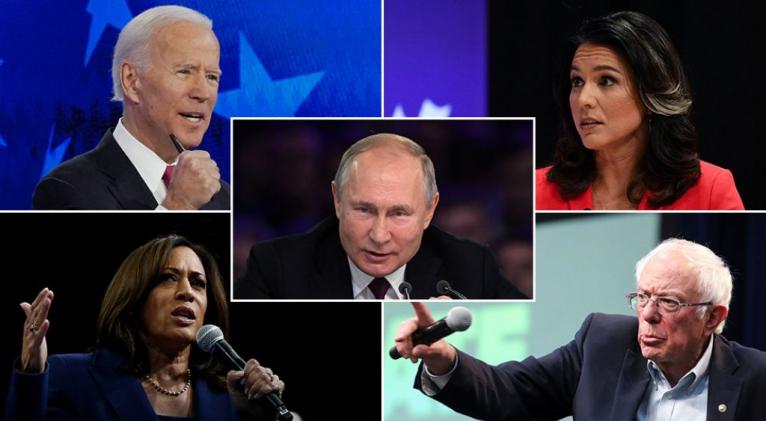Who does Putin want in the White House in 2020? ‘Experts’ suggest reading RT to find out
especiales

Russian bots are so 2016. The best way to decipher who Moscow wants in the White House in 2020 is to read RT. That’s according to internet sleuth Clint Watts, who is back with another timely analysis of Russian nefariousness.
Watts, for the uninitiated, is one of the most prolific media charlatans when it comes to fake Russian expertise – and one of the developers behind the ‘Hamilton 68’ dashboard ‘tracking’ Russian influence campaigns online. Launched with much fanfare in 2017, Hamilton 68’s popularity soon fizzled out as even the most ardent Russia critics admitted that media coverage of bot influence was “totally overblown.”
Experts in deceit
Now Watts is back with a new approach to “deciphering where, why, how and for whom” Russia might interfere in 2020. This time, he wants you to read RT and Sputnik – and to get you started, he and his team at the Boeing-funded Foreign Policy Research Institute (FPRI) have analyzed 1,711 articles so you don’t have to. But before we get into the results, it’s worth recalling one of the most egregious instances of dishonesty by Hamilton 68.
Jonathan Morgan, one of Watts’ co-developers on the project, was exposed by the New York Times last year for creating fake Russian bots and using them to convince Americans that Republican Senate candidate Roy Moore was being amplified on social media by Moscow-controlled accounts. The story grew legs when Morgan tweeted that Russian bots were “taking an interest” in Moore. The duplicitous scheme even got the so-called researcher kicked off Facebook for engaging in “coordinated inauthentic behavior.”
Biden? No thanks!
The first nugget of wisdom Watts imparts in his new analysis of Russian media is that RT is not a fan of Joe Biden. As VP during an administration which fear-mongered about Russia like it was going out of fashion, skeptical coverage of gaffe-plagued Biden on RT shouldn’t really bowl anyone over – but it’s hardly just RT. Biden’s “weakness” has been (somewhat surprisingly) well documented across US media, too. Even still, 44 percent of Biden coverage by RT and Sputnik was described as “neutral.”
Watts tells us that when it comes to Russian coverage, “Biden is to 2020 what Hillary Clinton was to 2016.” This is a (perhaps inadvertently) insightful observation, because Biden, as a centrist establishment Democrat suffering from an “enthusiasm gap” among Democrats, is indeed exactly what Clinton was in 2016 – but that’s another story entirely.
Elizabeth Warren? Meh…
Warren has “recently moved into the Kremlin’s crosshairs,” Watts informs us, admitting that the upward trend in mentions “coincides with her climb in the polls.” A truly shocking pattern, there.
If you were not intent on finding Russian nefariousness behind every meme, tweet and gif, you would simply leave it at that and accept that increased mentions of Warren (even negative ones) can be put down to the fact that she was suddenly catapulted to frontrunner status – rather than as evidence of a Russian influence campaign. Besides, Warren is no stranger to a bit of media-bashing, particularly over her anti-billionaire tax proposals.
Also on rt.com ‘War on Wall Street’? Billionaires declare themselves a persecuted minority
That’s clearly far too simple an explanation, though. As such, RT’s coverage of Warren “will be the focus of an upcoming separate post” from Watts – so stay tuned!
O’Rourke and Harris? Hard pass
Beto O’Rourke and Kamala Harris – two more candidates not averse to using a bit of anti-Russia hysteria to grab headlines – have shockingly not received glowing coverage from Russian media, either. While O’Rourke (a recent drop-out) received “consistently” negative coverage, mentions of Harris have “tailed off precipitously” in recent months.
That couldn’t possibly have something to do with the fact that Harris, who began as a self-described “top-tier” candidate, later tanked in the polls and is now being talked about as the next likely drop-out… could it?
Bernie Sanders? Take him or leave him
Bernie Sanders has received “mixed coverage” from Russian media, with an “even split of positive and negative mentions.” In fairness, that’s a hell of a lot better than mainstream US media, which isn’t exactly winning any awards for its coverage of the Vermont senator, which is so bad that it spawned the #BernieBlackout hashtag.
In one particularly audacious incident, the establishment-friendly MSNBC forgot to add Sanders to a graphic of 2020 contender headshots, but somehow managed to include Michael Bennett, who is polling at one percent. Oops?!
Watts’ time might be better spent analyzing American news media to decipher why things like this happen, rather than reading tea leaves at RT.
Tulsi Gabbard? Yes please
It should come as no surprise that Watts declared Gabbard the “overwhelming favorite” of Russian media – and it would be dishonest to deny that the anti-war candidate has received mostly sympathetic coverage at RT and Sputnik.
Gabbard’s anti-interventionist foreign policy stances and criticisms of US militarism have put her at the center of an exceptionally dirty establishment smear campaign, the goal of which is to cast her as a “Russian asset” in the eyes of American voters. RT, needless to say, chose not to jump on that particular bandwagon.
Of course, Watts leaves that part out.
Like many who have seen their media profiles grow thanks to feigned expertise on Russian “active measures,” Watts and crew have faced no real repercussions for their dishonesty so far – and so here we are again, watching as mainstream media takes their latest analysis oh so very seriously.
By Danielle Ryan, an Irish freelance writer based in Dublin. Her work has appeared in Salon, The Nation, Rethinking Russia, teleSUR, RBTH, The Calvert Journal and others.













Add new comment